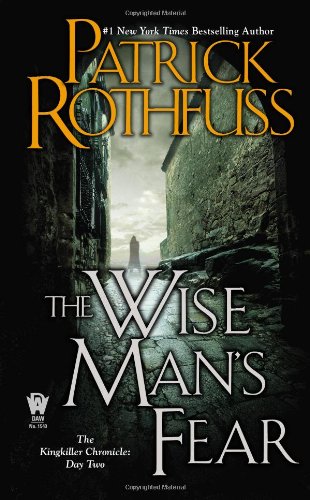The fiftieth posted set of notes on this blog.
For Isaac and Garrett.
1. So much sex. It felt like twenty percent of this novel was sex-scene. Three explanations spring to mind right off the bat: two pessimistic and probably wrong, one optimistic and probably right. First, perhaps Rothfuss was disappointed winning young adult literature awards for the last book, The Name of the Wind, and wanted to separate himself from that potential pigeon hole, so he added sex. Second, his audience grew four years since the last book, putting those young adults into puberty by now, and sex sells. These two pessimistic potential reasons are far from the simplest explanation though: it seems Kvothe is now 16, and sex is certainly a thing at that age. I believe this third reason, though there is still a lot of sex in this novel.
2. But Rothfuss writes the sex well: it lacks both sensationalism and stuffy moralizations. It’s not explicit, like George RR Martin is, but nor is it lightly implied and unconfirmed. He strikes a balance between the two that allows the sex to teach Kvothe much about himself, others, the world, history, the Fae, and morality. What I mean is that Rothfuss doesn’t moralize the sex, but through sex, Kvothe understands better how to treat other people and himself, how to do so morally—even in the differing morals of the different places and people he encounters. I want to say that he treats sex like he does magic and music, and mostly that’s true. It’s just that first sexual encounter with Felurian that potentially betrays that treatment. But even then, it’s treated like the first time Kvothe discovers his own music next to the pool in the forest, and his first sympathy in Ben’s cart. So yeah, the sex is treated like magic and music. It’s well done.
3. Rothfuss’ writing improves here: his sentence structures are slightly more complex, and he broadens the vocabulary he uses. This improvement is slight, but marked. It raises the quality from legible to readable—readable in the sense that I’m not constantly substituting words while reading it because I’m bored by his word choices, like I was in the first book. These minor changes increase the quality of the writing a lot. It’s a small change that makes the book much more enjoyable.
4. The improvement to the writing is necessary because this book is 1,000 pages long. If the writing hadn’t improved, this would’ve probably been a slog. One thousand pages is a long novel. Rothfuss uses 152 short chapters, averaging 6.54 pages per chapter. This is dangerous in that the short chapters break up the writing so much that it could feel like I’m constantly starting and stopping as a reader. By contrast, Martin uses long chapters to break up his long books: each is basically a short story. Here, each chapter is not short story: something happens in each chapter, something distinct, but it’s not quite as deep as a short story. Because Martin jumps around between characters in every chapter, he needs the longer chapters for supplementing his character building and making each chapter memorable so that when the book returns to that character a few chapters later, he doesn’t have to refresh the reader’s memory and slow down the story telling. Here Rothfuss sticks to Kvothe and keeps the story rolling, explaining even the travels between spaces in order to keep the focus on Kvothe’s story. It works for him with these short chapters.
5. Speaking of storytelling, Rothfuss is on fire here. Instead of a typical novel structure of one major crisis being built up, happening, then resolving, this is the story of Kvothe. He goes through many crises, resolves them, and then the novel stops. This isn’t a negative, because each portion of the book—college, Maer, bandit hunt, Fae, Adema, and college—are all self-contained novellas. In essence, this book is six novellas put together. Yet they’re all interconnected so closely that this novel works very well and the edges of each portion bleed into the next—most apparent at the end, when he returns to college and the story of his deeds in the other four portions catch up with him. This serial structure shows the novel's kinship to any series of short pulp fiction novellas. It could seem meandering if Kvothe didn't change from all of these experiences, but because he does, the novel is tight and a quick read.
6. As a character, Rothfuss shows and tells Kvothe well. The writing strikes a fine balance between showing Kvothe’s actions and reactions, and explaining Kvothe. One of Rothfuss’ tactics is borrowed from pulp fiction: he tells the action without letting the reader know the why, then explains it later. For instance, when Kvothe kills the troupe, it’s unclear to the reader what he thinks, why he’s angry. It feels very out of character for Kvothe and the novel, which is more violent than the first, but not as violent as most speculative fiction novels. But after the deed is done, the reader is let into Kvothe’s mind to justify his actions. This tactic let’s Rothfuss explain the killing in a chilling way, then explains Kvothe’s thinking and actions. In essence, this sets the reader at odds with Kvothe, makes them wonder why he is killing his family members, then explains it all away by showing what Kvothe knew that the reader didn’t—namely that this troupe wasn’t Edema Ruh. This tactic works because the payoff is quick in coming, not held from the reader for chapters and chapters. Rothfuss tells a story well, and he tells this one particularly well.
7. The theme of this novel is embracing the unknown, unknowable, and risk to gain knowledge and experience, but not being stupid about it. Kvothe doesn’t rush into battle against long odds, screaming and waving his arms. Rather, he plans and takes care and minimizes his risk, but still embraces the unknown to understand some known. Like when the element of surprise is lost in the bandit ambush, Kvothe makes the best of a bad situation, limits his exposure, but certainly has embraced some exposure just being there. A simple theme, sure, but supported well throughout the novel. This simplicity keeps the focus on the storytelling, as is appropriate for this book, which focuses everything on the storytelling.
8. As Garrett and I talked about this book, he brought up a point I wanted to write down for my own records: the past storyline is from Kvothe’s point of view moreso than many other first-person novels. For example, Devi is fairly one dimensional when introduced, but as the story progresses she gains more depth, especially here in the second book. This is because Kvothe understands more and more about her as time goes on. Kvothe is young and misunderstands people, categorizes them too rigidly on first meeting. But as with Denna beforehand, his understanding grows more accurate and wrinkled with more encounters. Kvothe is telling this story, so it makes sense that we only have his perspective on these characters he comes into contact with. This is initially off putting, making the characters seem one-dimensional on first meeting, but the payoff of seeing the characters grow more complex helps immensely to create reader’s trust in Rothfuss. The way he keeps everything so tightly focused through Kvothe’s perspective strongly supports the focus of the book being squarely on Kvothe's story.
9. In all, I found this book enjoyable, more so than the first. I think the pacing is perfect here, the writing improved, the characterizations more complex. I found the structure intriguing and appropriate to this biographical tale. The present storyline interludes continued to support the overarching mood of tragedy. I’m still curious about the story, and more so now. I look forward to the third book, and hope his writing improves even more.





.jpg/308px-Lute_(by_Princess_Ruto%2C_2013-02-11).jpg)



No comments:
Post a Comment